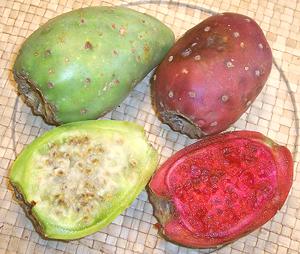 [Prickly Pear fruit, Beles (Ethiopia / Eritrea), Tzabar (Israel),
Ficodinnia (Italy), Opuntia ficus-indica]
[Prickly Pear fruit, Beles (Ethiopia / Eritrea), Tzabar (Israel),
Ficodinnia (Italy), Opuntia ficus-indica]
While there are many species of Opuntia, ficus-indica is by far the most economically important. Because it spread so widely so quickly it's exact point of origin was long uncertain, but recent DNA evidence shows it was domesticated from wild species native to central Mexico. It is known that Opuntia fruit were being eaten in Central America at least 9000 years ago. Today crops are grown throughout their original New World range and in arid regions of North Africa, Ethiopia, Eritrea, Israel and southern Italy.
In the early 20th century this fruit was being imported into the US from Sicily and other Mediterranean countries for consumption by recent Italian and Greek immigrants, but its use faded out in the 1950s. Today it is back, but imported from its land of origin, Mexico, for consumption within our large and growing Mexican and Central American immigrant communities.
The fruits also have antioxidant and other medicinal value and an extract of the fruit skins has been shown effective in preventing alcohol hangover. The fruits are also used to make a number of alcoholic beverages. The photo specimens were about 2-7/8 inches long, 2-3/8 inches diameter and weighed about 5-3/8 ounces each.
The fruits sprout from the edges of the cactus pads, which are also eaten as Nopales.
More on Cactus.
Tunas are used mainly to make juice, purée and syrups for use in drinks (both alcoholic and non-alcoholic) and various sauces, marinades, and deserts. These are available commercially in some parts of the US Southwest. Tunas are also eaten raw, just spooned out of their shells, particularly dark red ones.
cc_tunaz 081003 - www.clovegarden.com
©Andrew Grygus - agryg@clovegarden.com - Photos on this
page not otherwise credited are © cg1 -
Linking to and non-commercial use of this page permitted